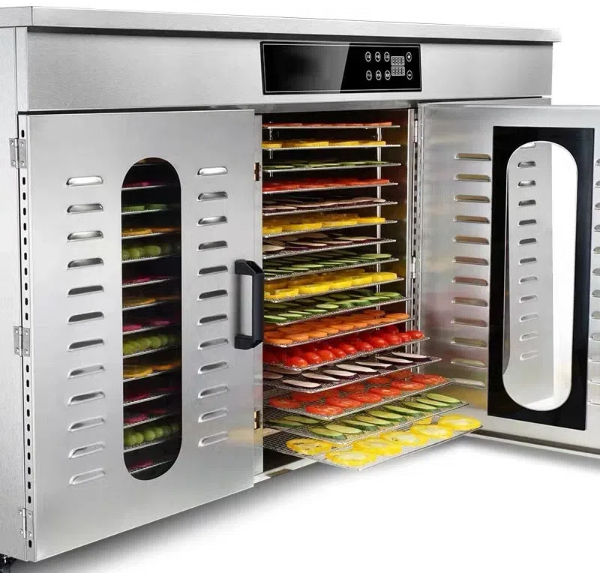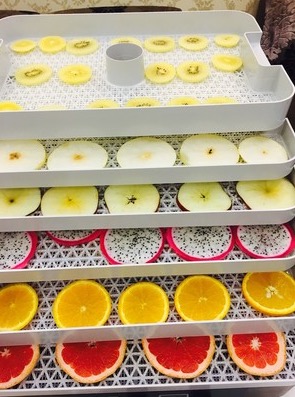
Content Menu
● Introduction to Commercial Dehydration Machines
>> Types of Commercial Dehydration Machines
● Key Features to Consider
>> 1. Capacity and Size
>> 2. Temperature Control
>> 3. Airflow Efficiency
>> 4. Material and Build Quality
>> 5. Maintenance and Support
● Benefits of Commercial Dehydration Machines
● Case Studies and Examples
● Market Trends and Future Developments
● Conclusion
● Frequently Asked Questions
>> 1. What is the ideal temperature range for dehydrating fruits and vegetables?
>> 2. How does airflow efficiency impact the dehydration process?
>> 3. What are the benefits of using stainless steel in commercial dehydration machines?
>> 4. How important is maintenance in extending the lifespan of a commercial dehydration machine?
>> 5. What factors should be considered when choosing a commercial dehydration machine for high-volume operations?
● Citations:
Choosing the right commercial dehydration machine is crucial for businesses involved in food processing, especially when it comes to commercial fruit and vegetable dehydration machines. These machines are designed to efficiently remove moisture from food products, enhancing their shelf life and preserving nutrients. In this article, we will explore the key factors to consider when selecting a commercial dehydration machine, including capacity, temperature control, airflow efficiency, and maintenance requirements.

Introduction to Commercial Dehydration Machines
Commercial dehydration machines are versatile appliances used in various industries, from food processing to pharmaceuticals. They work by circulating heated air around the food, which helps in removing moisture and preserving the product. These machines are essential for businesses looking to produce dried fruits, vegetables, meats, and other food products on a large scale.
Types of Commercial Dehydration Machines
1. Vertical vs. Horizontal Airflow:
- Vertical Airflow: These machines are more compact and suitable for smaller operations. They are often less expensive but may not provide as even drying as horizontal models.
- Horizontal Airflow: These models offer better airflow distribution, ensuring consistent drying across all trays. They are ideal for larger commercial operations.
2. Stackable vs. Sliding-Shelf Models:
- Stackable Models: Allow for easy expansion by adding more trays as needed.
- Sliding-Shelf Models: Provide easier access to trays, which can be beneficial for frequent monitoring and maintenance.
Key Features to Consider
1. Capacity and Size
When selecting a commercial fruit and vegetable dehydration machine, consider the volume of production required. Larger machines can handle more trays, allowing for greater quantities of food to be dehydrated simultaneously. This is crucial for high-volume operations where efficiency and productivity are paramount.
2. Temperature Control
A reliable temperature control system is essential for maintaining the quality of the dehydrated products. Different foods require specific temperature ranges for optimal dehydration:
- Herbs: 90-100°F
- Fruits & Vegetables: 130-160°F
- Meats/Jerky/Fish: 145-160°F
3. Airflow Efficiency
Effective airflow ensures uniform drying across all trays. Look for models with advanced airflow systems that minimize the need for tray rotation, saving time and labor.
4. Material and Build Quality
Stainless steel construction is preferred for its durability and ease of cleaning. It also ensures safety and compliance with food handling regulations.
5. Maintenance and Support
Choose a machine with easy-to-clean components and a comprehensive warranty. Good customer support can help resolve issues promptly, minimizing downtime.

Benefits of Commercial Dehydration Machines
1. Extended Shelf Life: Removes moisture, preventing bacterial growth and spoilage.
2. Nutrient Preservation: Low-temperature drying helps retain nutrients and enzymes.
3. Cost-Effective: Reduces food waste by allowing for bulk processing and storage.
Case Studies and Examples
Many businesses have successfully integrated commercial fruit and vegetable dehydration machines into their operations. For instance, a fruit processing company in Europe uses large-scale dehydration machines to produce dried fruits for the snack industry. This has significantly reduced their waste and increased their product offerings.
Additionally, a company specializing in organic produce has seen a significant increase in sales by offering dehydrated organic vegetables. This not only expands their product line but also caters to the growing demand for healthy, organic snacks.
Market Trends and Future Developments
The market for commercial dehydration machines is evolving rapidly, driven by consumer demand for healthier and more sustainable food options. Innovations in technology are leading to more efficient and environmentally friendly machines, such as those using solar power or advanced heat recovery systems.
Furthermore, there is a growing interest in using dehydration machines for preserving meats and seafood, which can help reduce the carbon footprint associated with refrigeration.
Conclusion
Selecting the right commercial fruit and vegetable dehydration machine requires careful consideration of several factors, including capacity, temperature control, airflow efficiency, and maintenance requirements. By choosing a machine that meets your business needs, you can enhance efficiency, reduce waste, and produce high-quality dried food products.

Frequently Asked Questions
1. What is the ideal temperature range for dehydrating fruits and vegetables?
The ideal temperature range for dehydrating fruits and vegetables is typically between 130°F and 160°F. This range helps preserve nutrients while ensuring effective moisture removal.
2. How does airflow efficiency impact the dehydration process?
Airflow efficiency is crucial for uniform drying. It ensures that all trays receive consistent heat, reducing the need for manual tray rotation and improving overall productivity.
3. What are the benefits of using stainless steel in commercial dehydration machines?
Stainless steel is preferred for its durability, ease of cleaning, and compliance with food safety standards. It also enhances the overall build quality of the machine.
4. How important is maintenance in extending the lifespan of a commercial dehydration machine?
Regular maintenance is vital for extending the lifespan of a commercial dehydration machine. It involves cleaning, checking for wear, and ensuring all components are functioning correctly.
5. What factors should be considered when choosing a commercial dehydration machine for high-volume operations?
For high-volume operations, consider machines with large capacities, efficient airflow systems, and robust build quality. Additionally, look for features like programmable timers and automatic tray rotation to enhance efficiency.
Citations:
[1] https://pleasanthillgrain.com/resources/dehydrators-buying-guide
[2] https://www.alibaba.com/showroom/fruit-dehydration-machine.html
[3] https://www.ike.cn/video.html
[4] https://www.mitchellcooper.co.uk/what-is-a-dehydrator-commercial-buying-guide
[5] https://machine.goldsupplier.com/blog/best-commercial-dehydrator/
[6] https://airtekdehydrator.com/blog/choosing-best-commercial-food-dehydrator/
[7] https://www.webstaurantstore.com/guide/741/food-dehydrators-buying-guide.html
[8] https://www.linkedin.com/advice/0/what-factors-should-you-consider-when-selecting-7lkle
[9] https://septree.com/blogs/news/how-to-choose-the-right-commercial-dehydrator-for-your-business-or-homestead
[10] https://excaliburdehydrator.com/pages/faqs
[11] https://airtekdehydrator.com/blog/purchasing-commercial-vegetable-drying-machine/
[12] https://aradmachineryco.com/article/Food-dehydrator-buying-guide
[13] https://www.reddit.com/r/dehydrating/comments/16htjuv/anyone_own_a_commercial_dehydrator_or_know_of_any/
[14] https://www.foodandwine.com/lifestyle/kitchen/best-food-dehydrators
[15] https://www.hachettebookgroup.com/storey/buying-food-dehydrator/
[16] https://www.shutterstock.com/search/electric-food-dehydrator
[17] https://www.shutterstock.com/search/food-dehydrator
[18] https://www.youtube.com/watch?v=OajsCNxW15g
[19] https://www.youtube.com/watch?v=bIXwQgg1N28
[20] http://www.dryer.comcastbiz.net/faqs.html
[21] https://www.linkedin.com/pulse/common-questions-food-dehydrators-aradmachinery
[22] https://www.commercialdehydrators.co.uk/dehydrators-blog
[23] https://www.dehydrate2store.com/howto/how-to-dehydrate-faq/
[24] https://food-dehydrator.com/pages/dehydrator-faq
[25] https://www.dehydratorsamerica.com/category/commercial-dehydrators
[26] https://www.dehydratorsamerica.com/category/industrial-food-dehydrators
[27] https://www.istockphoto.com/photos/food-dehydrator
[28] https://www.benchfoods.com/products/60-tray-dehydrator
[29] https://www.webstaurantstore.com/video-10845/avantco-food-dehydrator.html
[30] https://www.dehydratorsamerica.com/category/shop-all
[31] https://www.youtube.com/watch?v=IFugZm6TWzk
[32] https://www.reddit.com/r/dehydrating/comments/lxzg5p/difference_between_commercial_and_household/











